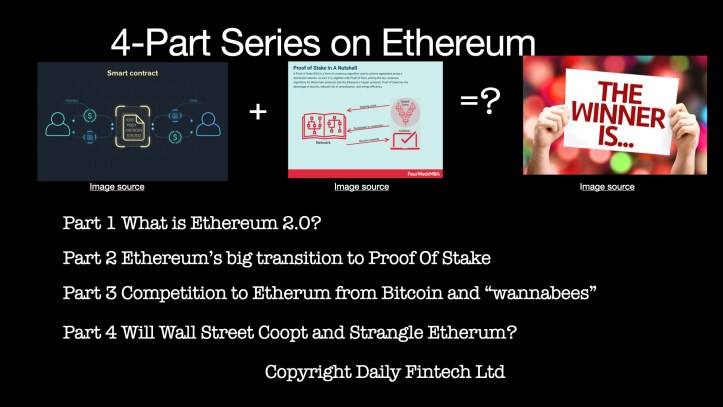Part 2 Ethereum’s big transition to Proof Of Stake

A much heralded part of Ethereum 2.0 is the transition to Proof Of Stake. It may happen during 2021 or 2022.
With Proof Of Stake, users validate transactions based on the number of coins they hold. For example, the more ETH a user has, the more power they possess. This is not mining, it is more like voting shares. Voting eliminates the energy needed for mining and should be faster, so that transactions can be done in under 3 seconds (ie “human real time”, short enough to impact consumer behaviour, as in “did you get my payment”, “wait, OK I see it, thanks”).
Proof Of Stake (POS) appeals to the financial establishment for 4 reasons:
1.Voting with your capital is how financial governance works today.
2. The ROI is easy to figure out; you can deploy capital and calculate yield vs price.
3. POS is easy for regulators; it is simply another way to deploy capital.
4. Taxation is easy to figure out; you can tax it like a dividend or bond yield.
Proof Of Stake will never happen on the Bitcoin Blockchain. Proof Of Work is the proven transaction validation model for Bitcoin, Lightning Network is the scalability solution and if you destroyed the mining business by destroying Proof Of Work, Bitcoin would collapse.
Ethereum has a transition issue with Proof Of Stake. It is an economic incentive issue not a technical issue. If you make money mining ETH using Proof Of Work, are you incentivised to switch to Proof Of Stake voting?
The fact that Ethereum is also working on scaling Proof Of Work using a technology similar to Lightning Network (Raiden) indicates they are hedging their bets.
Some subjects are too complex for our short attention spans, so we do 4 posts one week apart, each one short enough not to lose your attention but in aggregate doing justice to the complexity of the subject. Stay tuned by subscribing.
Part 3
Part 4
Some may not be published yet.
Daily Fintech’s original insight is made available to you for US$143 a year (which equates to $2.75 per week). $2.75 buys you a coffee (maybe), or the cost of a week’s subscription to the global Fintech blog – caffeine for the mind that could be worth $ millions.
Bitcoin, Blockchain, Cryptocurrencies Ethereum Proof-of-Stake
